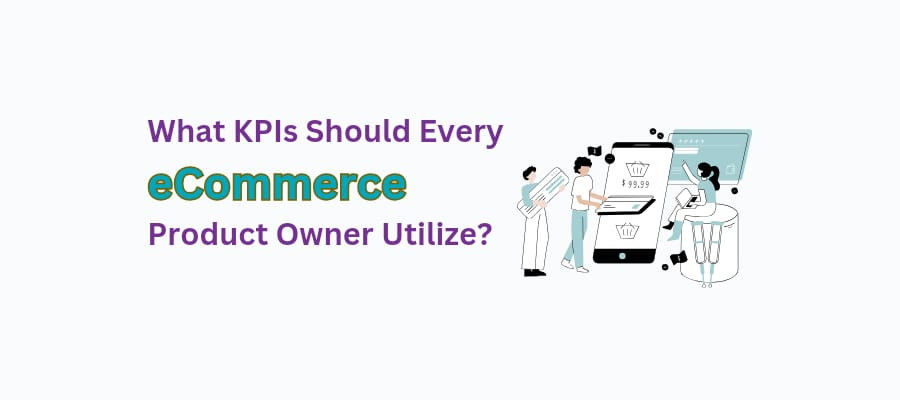What KPIs Should Every eCommerce Product Owner Utilize?

Are you currently working as an eCommerce Product Owner? When it comes to eCommerce, the role of the Product Owner is a bit different than other industry sectors. As an eCommerce Product Owner, you become accountable for the success or failure of a newly launched product line or existing product listing! That’s why you need to know the key performance indicators (KPIs) that every eCommerce Product Owner must track!
But before we discuss the KPIs, let’s quickly review the role of an eCommerce Product Owner!
What Are The Main Responsibilities Of An eCommerce Product Owner?
Being an eCommerce Product Owner entails a diverse set of responsibilities that are pivotal to the success of an online retail business. Here's a breakdown of the primary duties and tasks you might have to handle:
- Attain and Distribute Product Knowledge: eCommerce Product Owners delve deep into understanding the products offered on the platform. It involves researching existing product types, gathering insights from vendors and development teams, and building cases for product recommendations.
- Develop Customer Wireframes: E-commerce Product Owners' top priority is Ensuring optimal customer experiences. They develop wireframes based on customer preferences and usage patterns, manage product defects, and solicit customer and product team feedback for future enhancements.
- Confirm and Approve Product Delivery: Product delivery is a critical phase overseen by eCommerce Product Owners. They test products rigorously, confirm adherence to specifications, ensure regulatory compliance, and collaborate with senior management to schedule effective launches.
- Manage Product Finances: Financial management of products falls under the purview of eCommerce Product Owners. They work with company leadership to devise financial strategies, set pricing, analyze key business metrics, and develop financial plans to improve the company's product catalog.
Thus, e-commerce Product Owners play a multifaceted role in driving the success of online retail businesses.
Let’s Discuss The Key Performance Indicators (KPIs) For eCommerce Business Success:
So, what are the crucial KPIs every eCommerce Product Owner should utilize to drive growth and profitability? We’ll discuss those one by one!
1. Conversion Rate
One of the most critical KPIs for e-commerce Product Owners is the conversion rate. This metric measures the percentage of visitors to your website who make a purchase. According to research by BigCommerce, the average conversion rate for eCommerce websites is around 2.86%. However, top-performing eCommerce businesses achieve conversion rates much higher than this, often exceeding 5%.
2. Average Order Value (AOV)
Another crucial KPI for eCommerce Product Owners is the average order value (AOV). This metric represents the average amount of money customers spend on each order. By increasing the AOV, eCommerce businesses can maximize revenue and profitability.
Shopify says the average order value for e-commerce stores is $90. However, e-commerce Product Owners can significantly increase this figure through strategic pricing strategies and upselling techniques.
3. Customer Acquisition Cost (CAC)
Understanding the cost of acquiring new customers is essential for eCommerce Product Owners. Customer acquisition cost (CAC) measures the money spent on marketing and sales efforts divided by the number of new customers acquired.
According to a study by HubSpot, the average CAC across industries is around $100. However, eCommerce businesses may face higher or lower CAC depending on competition, advertising channels, and target audience.
4. Customer Lifetime Value (CLV)
In addition to understanding the cost of acquiring customers, eCommerce Product Owners should also consider the lifetime value of their customers. Customer lifetime value (CLV) represents a customer's total revenue over their relationship with a business. According to research by Kissmetrics, increasing customer retention rates by just 5% can increase profits by 25% to 95%. By focusing on CLV, eCommerce Product Owners can prioritize customer satisfaction and loyalty to drive long-term growth.
5. Cart Abandonment Rate
Cart abandonment rate is another important KPI for eCommerce Product Owners to monitor. This metric measures the percentage of visitors who add items to their shopping cart but leave the website without completing the purchase. According to research by Baymard Institute, the average cart abandonment rate for eCommerce websites is approximately 69.57%. ECommerce Product Owners can recover lost sales and improve conversion rates by analyzing the reasons for cart abandonment.
6. Website Traffic
Finally, eCommerce Product Owners should track website traffic as a key indicator of overall performance. Statista confirms that global eCommerce sales will reach $6.38 trillion this year itself! This KPI metric measures the number of visitors to your website over a specific period. ECommerce Product Owners can identify opportunities to attract more visitors by analyzing website traffic patterns.
It’s Time To Focus On Your eCommerce Business KPIs!
Did you get what KPIs you need to track as an eCommerce Product Owner? Understanding and optimizing these KPIs is essential for this year's growth and profitability!
E-commerce Product Owners can make data-driven decisions and efficiently improve their projects' sales by tracking conversion rate, average order value, and more metrics. Now, it’s your turn to start tracking the eCommerce KPIs!
Reference:
https://www.shopify.com/blog/7365564-32-key-performance-indicators-kpis-for-ecommerce
shttps://www.linkedin.com/pulse/e-commerce-product-owner-amit-garg/




